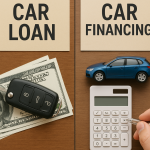

Leasing a Car in Canada Explained
Car Leasing in Canada
Car lease is one of the available financing options. It can be a great choice for those who are not committed to buying a car. Since a good understanding of the subject is vital for making a smart and confident decision, in this guide, we explain the key aspects of a car lease.
What is a Car Lease?
Simply put, a car lease lets you borrow a vehicle, usually brand new, for a fixed time period. At the end of the term, the car must be returned to the lease provider or purchased. The key difference from a typical financing option is in what you are paying for. With a lease, you don’t pay for owning a car – you pay for using it.
Costs associated with a car lease normally include a down payment and monthly payments, including rental costs, interest, taxes, and depreciation costs. Note that there can be other potential fees, so carefully studying your lease agreement is a must!
Benefits of Leasing a Car
There are quite a few benefits of leasing a car rather than buying it. Here are the most enticing:
- Lower payments. As there is no ownership involved, you only pay for the vehicle depreciation.
- Always new. A car lease lets you drive a brand new car every couple of years without committing to ownership. With car lease as your main strategy, you can regularly get the cream of the latest technologies offered by car manufacturers.
- Problem-free. A typical 2-year lease agreement is perfect for using a car while it’s new and doesn’t need frequent repairs.
- Warranty. Each time you lease, you get a warranty that sometimes covers servicing and oil changes.
- Return and forget. Just return the car and leave all the troubles of its further fate to the lease provider.
Disadvantages of Leasing a Car
With all the pros and perks of leasing a car do come certain disadvantages you need to understand and agree to before opting-in:
- You don’t own a car that you lease. Once the lease ends, you will have to make a decision: start over again or purchase the vehicle from the lease provider at additional costs. While you can save money within a single lease agreement, sticking to it, in the long run, may end up more costly than buying a vehicle. So unless you really want to regularly drive a new car, owning a car may be a wiser choice long term.
- Restrictions. Each lease agreement comes with limiting guidelines on what you can do during the contract period. Typically, these would include annual mileage caps, maintaining the proper physical condition of the vehicle like avoiding damages, excessive wear, and modifications. Failing to meet these restrictions can incur extra charges that you should be potentially prepared for.
- Penalty fees. A lease is a good option as long as you follow the agreement to the very end of its duration. Any changes along the way will hit your pocket significantly. For one, buying off a car at the end of the lease term will likely cost you more than purchasing it using a more traditional financing option. Likewise, an early termination of the agreement will normally cost you as much as the remaining cash amount of the entire lease unless you find someone willing to take over your lease.
Car Lease Options
Leasing a car in Canada can be fine-tuned with a few options depending on your needs:
Standard rental lease
This is the most traditional form of lease: you get to drive a brand new car for the duration of the term, after which you return the car or extend the lease.
Lease to own
This option lets you purchase a car at the end of the lease term. In this case, your monthly payments will include both rental costs and equity.
Lease takeover
By taking over someone else’s lease, you enter into the agreement midway. You can get a good deal, but you also inherit the responsibility for the vehicle’s condition, performance, exceeded mileage limits. Be sure to study the agreement carefully to avoid unpleasant surprises.
Used car lease
Leasing a used car may look like a good deal, but it can mean increased maintenance and repair costs due to the vehicle’s aging and expired warranty.
Steps Needed to Lease a Car
Each step is explained in detail in our step-by-step guide to leasing a car.
- Understand a Car Lease
- Do a Credit Score Check
- Calculate Your Budget
- Choose the Right Car
- Consider Ownership
- Examine Your Lease Agreement
- Make Regular Payments
- Follow Maintenance
Get the Most of a Car Lease with Vehicle Approval Centre
As you can see, leasing a car in Canada isn’t rocket science but can be time-consuming and asks for a very responsible decision to be made. Save yourself some trouble and let the professionals help you with your decision and find the best deals.
Start by completing our quick online application and one of our agents will be on it in no time!
Related posts

2025-07-23
Purchasing a new car can be an exhilarating experience, filled with the promise of modern features and the...

How to get a car loan with bankruptcy in Atlantic Canada
CarEvo
2025-07-23
Car loans after experiencing bankruptcy can feel daunting. Many individuals worry that their financial history will prevent them...

Top FAQs About Financing Options for Used Cars in Canada
Carevo
2024-03-15
Are you considering financing a used car in Canada? It’s a fantastic choice for those seeking an affordable...

0% Interest Car Loans in Canada: Know the Facts Behind Them
Carevo
2024-03-11
Have you ever seen those 0% financing offers in car ads and thought, “Free money, sign me up!”...
Award-winning, Maritime dealership of new and pre-owned vehicles with several locations across the Maritimes. Best Deals & the best customer service guaranteed.
Copyright © 2023-2025 CarEvo. All rights reserved.




